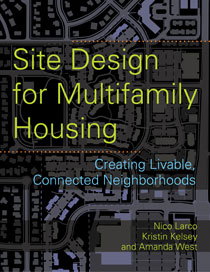"[A] straightforward guide that offers design criteria for pedestrian networks, street design, open space, landscape design, and more..."
Landscape Architecture Magazine
"Site Design for Multifamily Housing offers designers, developers and planners clear and cogent site design advice for improving connectivity, walkability and livability—features that are crucial to the design of better, more resilient suburban futures—all in an easily-referenced handbook format."
June Williamson, Associate Professor of Architecture at The City College of New York
"This book-- direct, concise, practical-- fits nicely into what may be a developing genre of guides to achieving greater sustainability without megaprojects and without immediate radical change in everyone's mind-set."
Planning
"This invaluable 'how-to' guidebook demonstrates easily understandable interventions that can be championed by the array of participants in city building. Site Design for Multifamily Housing is a distinguished and timely resource that will clearly motivate the transformation of North American suburban contexts to be more connected, livable, and enjoyable."
Scot Hein, Senior Urban Designer, City of Vancouver
"Site Design for Multifamily Housing is a much-needed urban planning resource that will encourage infills, retrofits, and the improvement of existing suburban sites through the introduction of design and coding techniques for better connectivity and better urbanism that are attractive to the emerging markets."
Galina Tachieva, partner and Director of Town Planning at Duany Plater-Zyberk & Company

